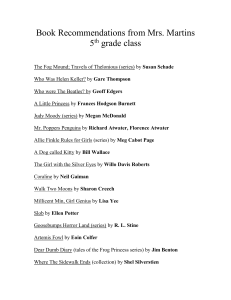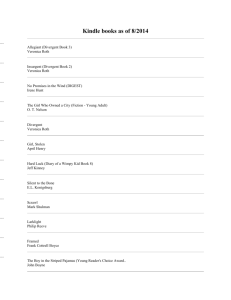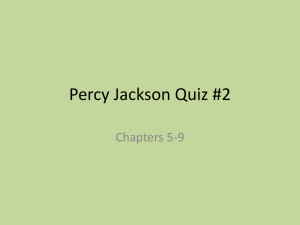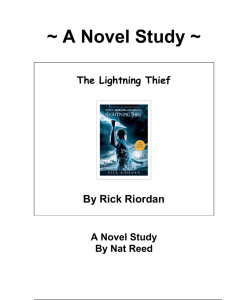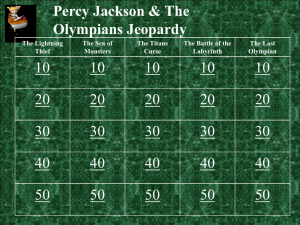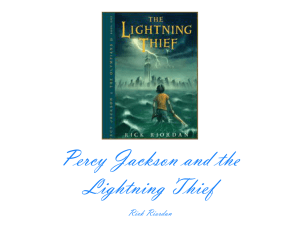8D5.Payne
advertisement
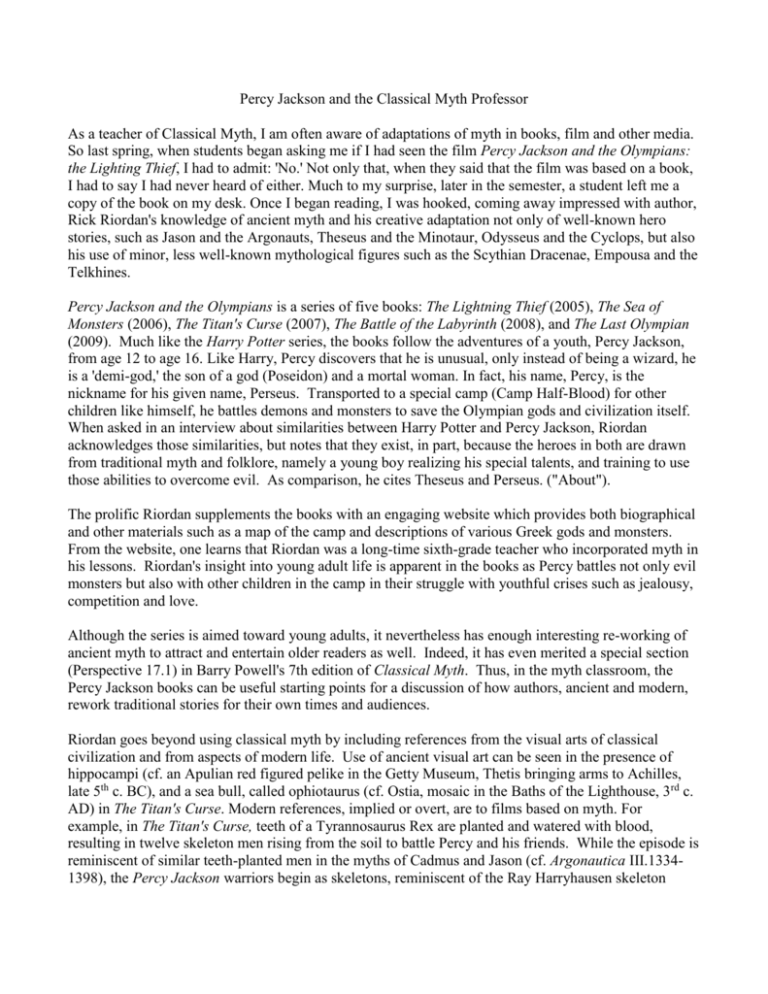
Percy Jackson and the Classical Myth Professor As a teacher of Classical Myth, I am often aware of adaptations of myth in books, film and other media. So last spring, when students began asking me if I had seen the film Percy Jackson and the Olympians: the Lighting Thief, I had to admit: 'No.' Not only that, when they said that the film was based on a book, I had to say I had never heard of either. Much to my surprise, later in the semester, a student left me a copy of the book on my desk. Once I began reading, I was hooked, coming away impressed with author, Rick Riordan's knowledge of ancient myth and his creative adaptation not only of well-known hero stories, such as Jason and the Argonauts, Theseus and the Minotaur, Odysseus and the Cyclops, but also his use of minor, less well-known mythological figures such as the Scythian Dracenae, Empousa and the Telkhines. Percy Jackson and the Olympians is a series of five books: The Lightning Thief (2005), The Sea of Monsters (2006), The Titan's Curse (2007), The Battle of the Labyrinth (2008), and The Last Olympian (2009). Much like the Harry Potter series, the books follow the adventures of a youth, Percy Jackson, from age 12 to age 16. Like Harry, Percy discovers that he is unusual, only instead of being a wizard, he is a 'demi-god,' the son of a god (Poseidon) and a mortal woman. In fact, his name, Percy, is the nickname for his given name, Perseus. Transported to a special camp (Camp Half-Blood) for other children like himself, he battles demons and monsters to save the Olympian gods and civilization itself. When asked in an interview about similarities between Harry Potter and Percy Jackson, Riordan acknowledges those similarities, but notes that they exist, in part, because the heroes in both are drawn from traditional myth and folklore, namely a young boy realizing his special talents, and training to use those abilities to overcome evil. As comparison, he cites Theseus and Perseus. ("About"). The prolific Riordan supplements the books with an engaging website which provides both biographical and other materials such as a map of the camp and descriptions of various Greek gods and monsters. From the website, one learns that Riordan was a long-time sixth-grade teacher who incorporated myth in his lessons. Riordan's insight into young adult life is apparent in the books as Percy battles not only evil monsters but also with other children in the camp in their struggle with youthful crises such as jealousy, competition and love. Although the series is aimed toward young adults, it nevertheless has enough interesting re-working of ancient myth to attract and entertain older readers as well. Indeed, it has even merited a special section (Perspective 17.1) in Barry Powell's 7th edition of Classical Myth. Thus, in the myth classroom, the Percy Jackson books can be useful starting points for a discussion of how authors, ancient and modern, rework traditional stories for their own times and audiences. Riordan goes beyond using classical myth by including references from the visual arts of classical civilization and from aspects of modern life. Use of ancient visual art can be seen in the presence of hippocampi (cf. an Apulian red figured pelike in the Getty Museum, Thetis bringing arms to Achilles, late 5th c. BC), and a sea bull, called ophiotaurus (cf. Ostia, mosaic in the Baths of the Lighthouse, 3rd c. AD) in The Titan's Curse. Modern references, implied or overt, are to films based on myth. For example, in The Titan's Curse, teeth of a Tyrannosaurus Rex are planted and watered with blood, resulting in twelve skeleton men rising from the soil to battle Percy and his friends. While the episode is reminiscent of similar teeth-planted men in the myths of Cadmus and Jason (cf. Argonautica III.13341398), the Percy Jackson warriors begin as skeletons, reminiscent of the Ray Harryhausen skeleton warriors in the film, Jason and the Argonauts. More overt references to film can also be seen. Take the comment in The Last Olympian as Percy reacts to seeing blue-skinned, green-eyed mermen with shark teeth: "They don't show you that in Little Mermaid!" In this paper I will examine how Riordan adapts and reworks these and other elements of ancient myth from ancient textual and visual arts combining them with elements from modern life to present an engaging set of stories. Works Cited "About Rick: An Interview with Rick." Welcome to the Online World of Rick Riordan. N.d. http://www.rickriordan.com/about-rick/an-interview-with-rick.aspx Powell, Barry, "Rick Riordan's Percy Jackson." Classical Myth. 7th edn. Boston: Pearson. 2012. 457458. Riordan, Rick. Percy Jackson and the Olympians. New York: Disney/Hyperion. 2005-2009. Print. Welcome to the Online World of Rick Riordan. N.d. http://www.rickriordan.com/home.aspx
